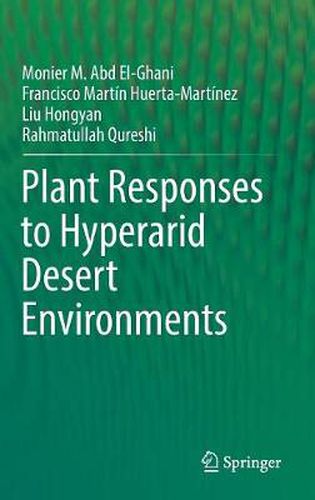Readings Newsletter
Become a Readings Member to make your shopping experience even easier.
Sign in or sign up for free!
You’re not far away from qualifying for FREE standard shipping within Australia
You’ve qualified for FREE standard shipping within Australia
The cart is loading…






This title is printed to order. This book may have been self-published. If so, we cannot guarantee the quality of the content. In the main most books will have gone through the editing process however some may not. We therefore suggest that you be aware of this before ordering this book. If in doubt check either the author or publisher’s details as we are unable to accept any returns unless they are faulty. Please contact us if you have any questions.
This book provides a comprehensive discussion on plant responses in hyperarid regions of Egypt, China, Mexico, and Pakistan. It describes their location, physiographic features, accidental vegetation along two transects, endangered vegetation species, human impact, and variety of plant types (e.g. climbing, succulent, and parasitic). Studies on biotic and abiotic interactions, plant biodiversity, and soil-plant relationships are also covered.
Covering a wide range of plant conditions and adaptations, this book analyzes what happens when plants must endure very high temperatures and aridity. Plants have adapted by evolving their physical structure to store and conserve water. Examples are the absence of leaves which reduces transpiration and the growth of extremely long roots, allowing them to acquire moisture at, or near the water table. Plants in hyperarid habitats have also made behavioral adaptations in order to survive by synchronizing with the seasons of greatest moisture and/or coolest temperatures. For example, desert perennials remain dormant during dry periods of the year, then spring to life when water becomes available.
The book includes many color illustrations, and has extensive and up-to-date references for further reading.
$9.00 standard shipping within Australia
FREE standard shipping within Australia for orders over $100.00
Express & International shipping calculated at checkout
This title is printed to order. This book may have been self-published. If so, we cannot guarantee the quality of the content. In the main most books will have gone through the editing process however some may not. We therefore suggest that you be aware of this before ordering this book. If in doubt check either the author or publisher’s details as we are unable to accept any returns unless they are faulty. Please contact us if you have any questions.
This book provides a comprehensive discussion on plant responses in hyperarid regions of Egypt, China, Mexico, and Pakistan. It describes their location, physiographic features, accidental vegetation along two transects, endangered vegetation species, human impact, and variety of plant types (e.g. climbing, succulent, and parasitic). Studies on biotic and abiotic interactions, plant biodiversity, and soil-plant relationships are also covered.
Covering a wide range of plant conditions and adaptations, this book analyzes what happens when plants must endure very high temperatures and aridity. Plants have adapted by evolving their physical structure to store and conserve water. Examples are the absence of leaves which reduces transpiration and the growth of extremely long roots, allowing them to acquire moisture at, or near the water table. Plants in hyperarid habitats have also made behavioral adaptations in order to survive by synchronizing with the seasons of greatest moisture and/or coolest temperatures. For example, desert perennials remain dormant during dry periods of the year, then spring to life when water becomes available.
The book includes many color illustrations, and has extensive and up-to-date references for further reading.